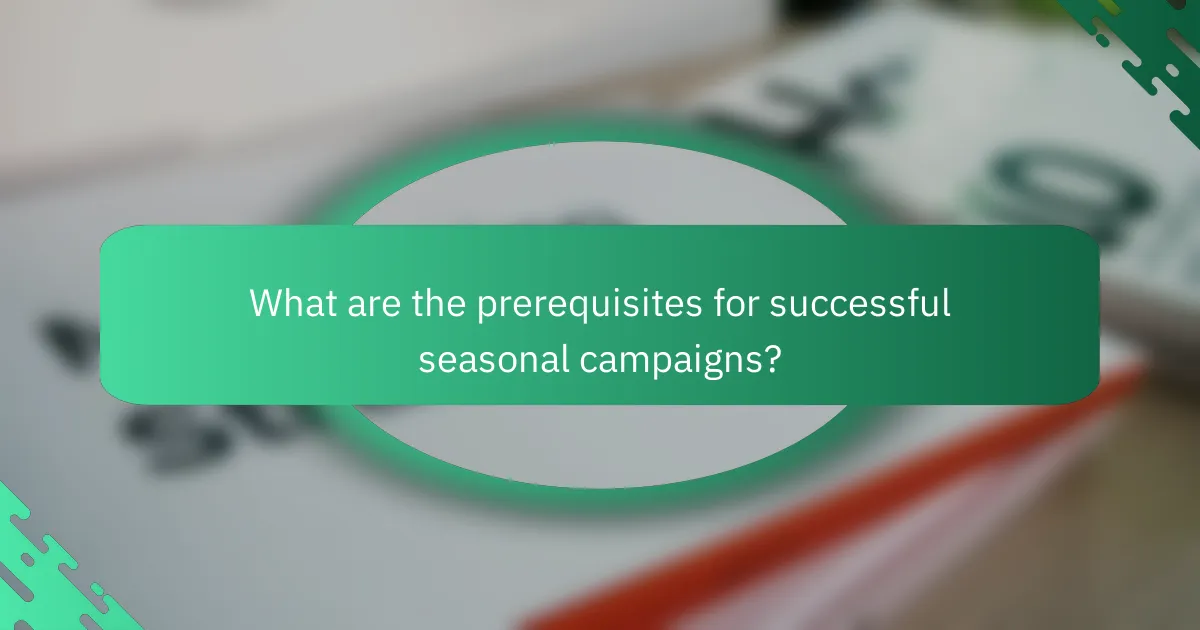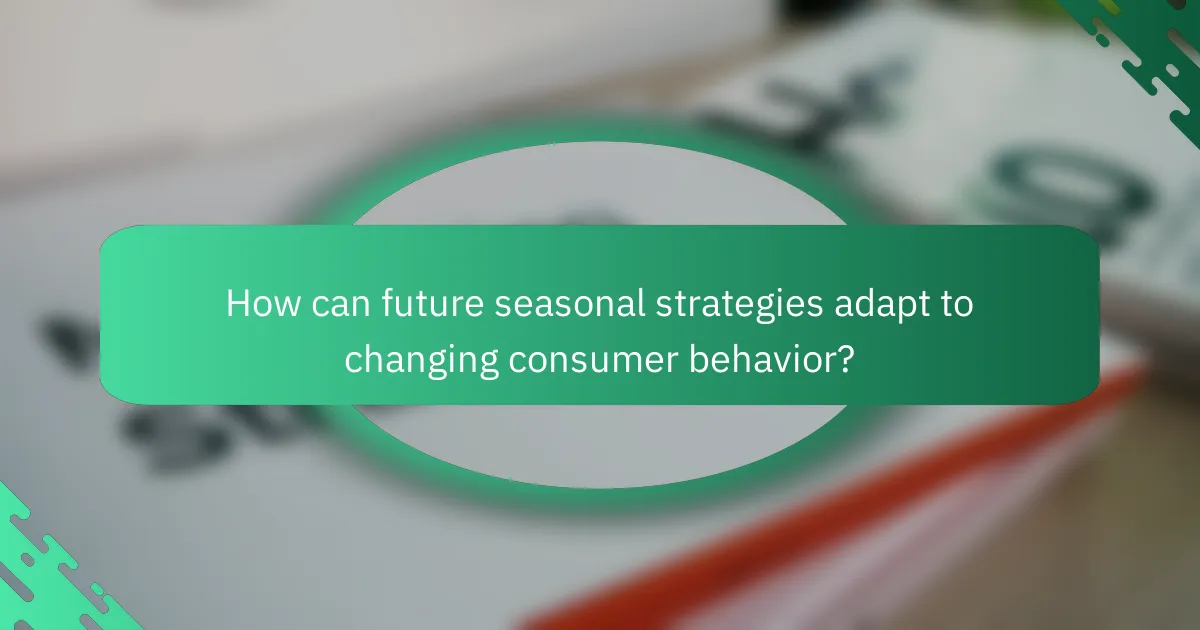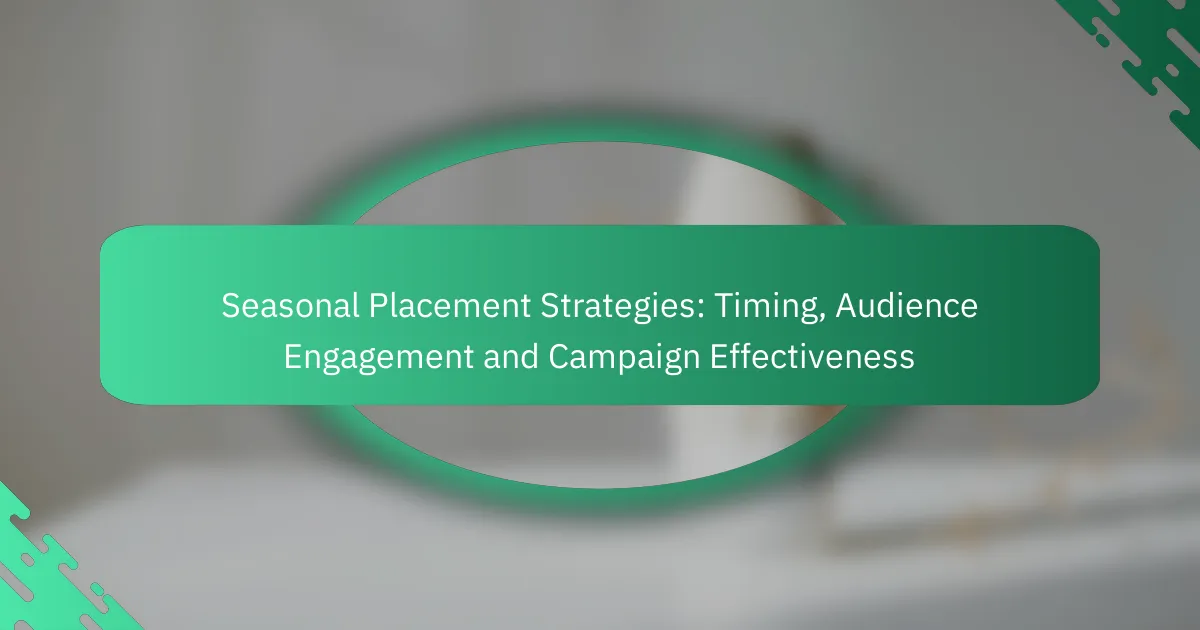Sezonālo izvietojuma stratēģiju efektivitāte Latvijā prasa reklāmas aktivitāšu saskaņošanu ar vietējiem svētkiem un notikumiem, lai maksimāli palielinātu auditorijas iesaisti un kampaņu efektivitāti. Izprotot mērķauditorijas laika un priekšroku nianses, uzņēmumi var uzlabot savu redzamību un sasniegt labākus rezultātus sezonas laikā.

What are effective seasonal placement strategies in Latvia?
Effective seasonal placement strategies in Latvia involve aligning advertising efforts with local holidays and events to maximize audience engagement and campaign effectiveness. By understanding the timing and preferences of the target audience, businesses can enhance their visibility and drive better results during peak seasons.
Targeted display ads during holidays
Targeted display ads during holidays can significantly boost engagement in Latvia. By focusing on specific holidays such as Jāņi or Christmas, brands can tailor their messaging and visuals to resonate with local customs and traditions.
Consider using festive themes and local symbols in your ads to create a connection with the audience. For example, incorporating traditional Latvian elements can enhance relatability and encourage clicks. Timing is crucial; launch your campaigns a few weeks before the holiday to build anticipation.
Utilizing local events for engagement
Leveraging local events is a powerful way to engage audiences in Latvia. Events like the Riga City Festival or the Latvian Song and Dance Festival attract large crowds and provide an opportunity for brands to connect with potential customers.
Participating in these events through sponsorships or on-site promotions can enhance brand visibility. Additionally, consider creating event-specific content or promotions that encourage attendees to interact with your brand, such as contests or giveaways.
Optimizing ad timing for peak seasons
Optimizing ad timing is essential for maximizing impact during peak seasons in Latvia. Key shopping periods, such as the back-to-school season or Black Friday, require strategic planning to ensure your ads reach consumers when they are most likely to purchase.
Monitor consumer behavior trends and adjust your ad placements accordingly. A good practice is to start campaigns a few weeks before peak shopping days and maintain a strong presence throughout the season. Avoid last-minute rushes, as they can lead to missed opportunities and ineffective campaigns.

How to engage audiences during seasonal campaigns?
Engaging audiences during seasonal campaigns requires a strategic approach that focuses on personalization, interactivity, and real-time communication. By tailoring content to local preferences and utilizing various platforms, brands can enhance their connection with consumers and improve campaign effectiveness.
Personalized content for local audiences
Creating personalized content for local audiences is crucial for resonating with consumers during seasonal campaigns. This involves understanding cultural nuances and preferences, which can vary significantly from one region to another. For example, a campaign in Latvia during Jāņi (Midsummer) could highlight traditional customs and local products.
Utilize data analytics to segment your audience based on demographics and behaviors. This allows for targeted messaging that speaks directly to the interests and needs of specific groups. Consider using localized language and imagery to create a stronger emotional connection.
Interactive ads to boost engagement
Interactive ads can significantly enhance audience engagement by encouraging participation. Formats such as quizzes, polls, and interactive videos invite users to interact with the content, making the experience more memorable. For instance, a holiday-themed quiz that offers personalized product recommendations can drive both engagement and conversions.
Ensure that interactive elements are easy to use and accessible across devices. Track user interactions to gather insights on preferences and adjust your strategy accordingly. Avoid overly complex interactions that could frustrate users and lead to drop-offs.
Utilizing social media for real-time interaction
Social media platforms are essential for real-time interaction with audiences during seasonal campaigns. Use these channels to share timely updates, respond to customer inquiries, and engage in conversations. Live events or Q&A sessions can create a sense of urgency and excitement around your campaign.
Leverage hashtags and trends relevant to the season to increase visibility and encourage user-generated content. Monitor engagement metrics to assess the effectiveness of your social media efforts and adjust your strategy as needed. Avoid neglecting responses to comments and messages, as this can diminish trust and engagement.

What metrics measure campaign effectiveness?
Campaign effectiveness can be measured through various metrics that indicate how well a campaign achieves its objectives. Key metrics include click-through rates, conversion rates, and audience retention, each providing insights into different aspects of campaign performance.
Click-through rates for seasonal ads
Click-through rates (CTR) for seasonal ads reflect the percentage of users who click on an advertisement after viewing it. A higher CTR indicates that the ad is engaging and relevant to the audience. Typically, seasonal ads can see CTRs ranging from low single digits to high teens, depending on the timing and targeting.
To improve CTR, focus on creating compelling visuals and clear calls to action. Seasonal themes can enhance relevance, but ensure that the messaging aligns with the audience’s expectations during that period.
Conversion rates during peak seasons
Conversion rates measure the percentage of users who complete a desired action, such as making a purchase, after interacting with an ad. During peak seasons, conversion rates can significantly increase, often reaching double digits, as consumers are more inclined to buy due to festive promotions.
To maximize conversion rates, optimize landing pages for seasonal campaigns by ensuring they are user-friendly and relevant. Consider offering limited-time discounts or exclusive seasonal products to entice customers further.
Audience retention post-campaign
Audience retention post-campaign refers to the ability to keep customers engaged after a seasonal campaign ends. High retention rates indicate that the campaign successfully built a connection with the audience. Retention can vary widely, but maintaining a percentage in the low to mid-thirties is often considered good.
To enhance audience retention, follow up with personalized communication after the campaign, such as thank-you emails or loyalty rewards. Engaging content that continues the seasonal theme can help maintain interest and encourage repeat business.

What are the prerequisites for successful seasonal campaigns?
Successful seasonal campaigns require a clear understanding of timing, audience engagement, and effective strategies tailored to specific demographics. Key prerequisites include thorough market research, audience analysis, and a well-defined campaign timeline that aligns with seasonal trends.
Understanding audience demographics
To effectively engage your audience during seasonal campaigns, it’s crucial to understand their demographics, including age, gender, location, and purchasing behavior. This information helps tailor your messaging and product offerings to resonate with your target market.
For example, if your campaign targets younger consumers, consider using platforms like social media for promotion, while older demographics may respond better to email marketing or traditional media. Segmenting your audience can enhance engagement and conversion rates.
Researching seasonal trends in Latvia
In Latvia, seasonal trends can significantly influence consumer behavior and preferences. Researching these trends involves analyzing past sales data, monitoring competitor strategies, and keeping an eye on local events and holidays that may affect purchasing patterns.
For instance, during the winter holidays, consumers may prioritize gifts and festive products, while summer might see a rise in outdoor and travel-related purchases. Utilizing tools like Google Trends or local market reports can provide valuable insights into these seasonal shifts.

How to analyze previous seasonal campaigns?
To analyze previous seasonal campaigns, focus on evaluating performance metrics and audience engagement. This process helps identify what worked well and what can be improved for future campaigns.
Reviewing past performance data
Start by gathering data from previous campaigns, including metrics such as conversion rates, click-through rates, and overall sales figures. Look for trends over different seasons to understand which periods yielded the best results.
Utilize tools like Google Analytics or social media insights to track user behavior and engagement. Comparing these metrics against industry benchmarks can provide context for your performance.
Identifying successful strategies
Analyze which marketing strategies were most effective during past campaigns. This could include promotional tactics, content types, or specific channels that drove higher engagement.
Consider creating a checklist of successful elements, such as targeted email campaigns, social media ads, or influencer partnerships. Identifying these strategies can guide future campaign planning and execution.

What are the emerging trends in seasonal advertising?
Emerging trends in seasonal advertising focus on leveraging technology and sustainability to enhance audience engagement and campaign effectiveness. Advertisers are increasingly adopting innovative strategies that resonate with consumer values and preferences during peak seasons.
Increased use of AI in ad targeting
The integration of artificial intelligence (AI) in ad targeting allows marketers to analyze consumer behavior more effectively. By utilizing machine learning algorithms, advertisers can identify patterns and preferences, enabling them to deliver personalized content that aligns with seasonal interests.
For instance, AI can help predict which products are likely to be popular during specific holidays, allowing brands to optimize their inventory and marketing strategies accordingly. This targeted approach can lead to higher conversion rates and improved return on investment.
Focus on sustainability in campaigns
Consumers are increasingly prioritizing sustainability, prompting brands to incorporate eco-friendly practices into their seasonal campaigns. This trend involves not only promoting sustainable products but also adopting environmentally responsible marketing strategies.
Brands can engage audiences by highlighting their commitment to sustainability, such as using recyclable materials in packaging or supporting local communities. For example, a brand might launch a seasonal campaign that emphasizes its efforts to reduce carbon emissions, appealing to environmentally conscious consumers.
Integration of augmented reality experiences
Augmented reality (AR) is becoming a popular tool in seasonal advertising, providing immersive experiences that captivate audiences. By allowing consumers to interact with products in a virtual space, AR can enhance engagement and drive sales during peak shopping periods.
For example, a furniture retailer might use AR to let customers visualize how a piece of furniture would look in their home before making a purchase. This interactive approach not only boosts consumer confidence but also creates a memorable shopping experience that can lead to higher sales during seasonal campaigns.

How can future seasonal strategies adapt to changing consumer behavior?
Future seasonal strategies must be flexible and data-driven to effectively respond to evolving consumer behavior. By analyzing trends and preferences, businesses can tailor their campaigns to better engage their audience and enhance overall effectiveness.
Timing Considerations
Timing is crucial for seasonal strategies, as consumer interest can fluctuate significantly based on various factors. Businesses should monitor key dates, such as holidays and local events, to align their campaigns with peak shopping periods. Utilizing historical data can help identify optimal times for launching promotions.
For instance, retailers often see increased sales during the weeks leading up to Christmas. Planning campaigns to start early in the season can capture consumer attention before competitors do.
Audience Engagement Techniques
Engaging the audience effectively requires understanding their preferences and behaviors. Utilizing personalized marketing tactics, such as targeted emails and social media ads, can significantly enhance engagement. Surveys and feedback mechanisms can also provide insights into what consumers are looking for during specific seasons.
For example, a brand may use social media polls to gauge interest in potential holiday products, allowing them to tailor their offerings accordingly. This approach not only boosts engagement but also fosters a sense of community among consumers.
Campaign Effectiveness Measurement
Measuring the effectiveness of seasonal campaigns is essential for future improvements. Key performance indicators (KPIs) such as conversion rates, engagement metrics, and return on investment (ROI) should be tracked closely. This data helps identify what worked well and what needs adjustment for future campaigns.
Businesses can use tools like Google Analytics to assess traffic and sales data during seasonal promotions. Regularly reviewing these metrics allows for timely adjustments to strategies, ensuring campaigns remain relevant and impactful.



